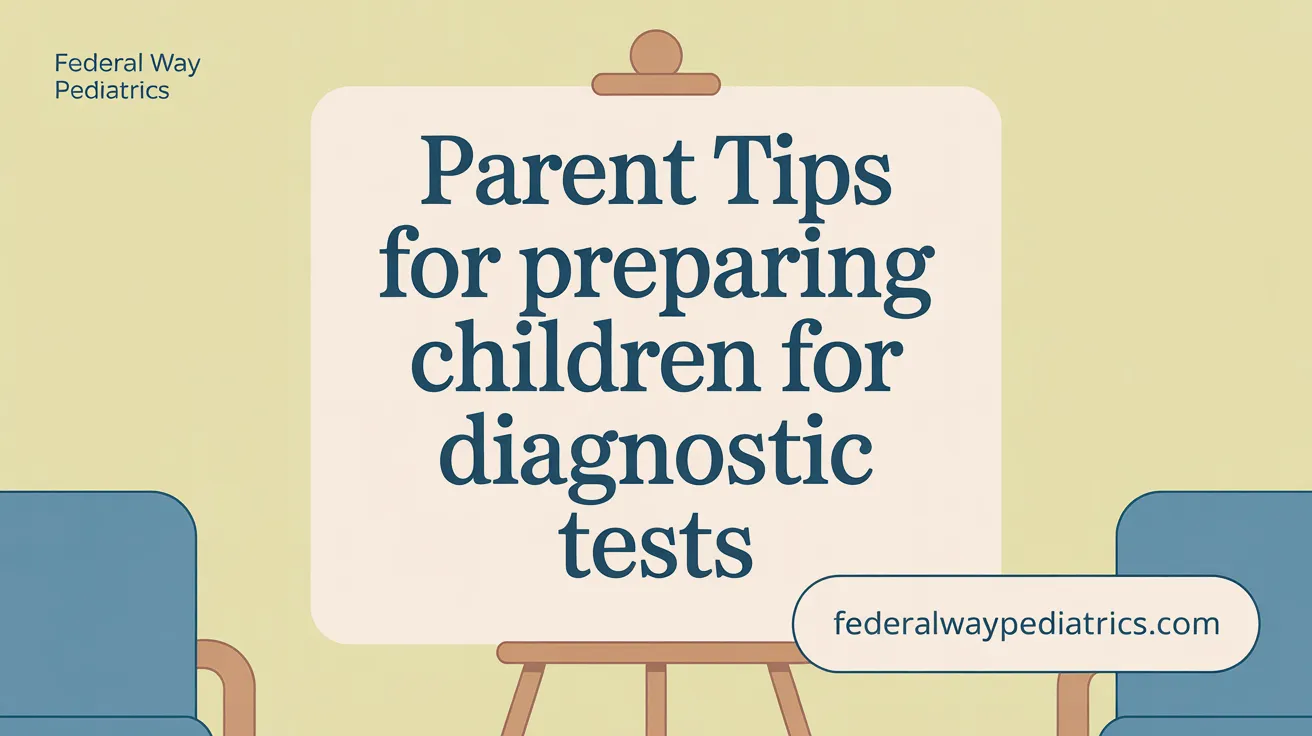Understanding Diagnostic Services for Children
Diagnostic services play a crucial role in pediatric healthcare, providing essential insights into the health status of infants, children, and adolescents. This article outlines what parents and caregivers can expect when their child undergoes diagnostic testing, covering a variety of procedures and tests designed specifically for pediatric patients. From advanced imaging techniques to preparing children emotionally and physically for tests, we explore the comprehensive care approach that medical providers use to ensure accurate diagnoses and gentle experiences for young patients.
Overview of Pediatric Diagnostic Tests and Procedures

What types of diagnostic tests are commonly performed for pediatric patients?
Pediatric patients undergo a broad spectrum of diagnostic tests designed to assess various aspects of health safely and effectively. Common imaging procedures include angiograms for pediatric patients for visualizing blood vessels, CT scans for children and MRI scans without X-rays to capture detailed internal body images, and ultrasound imaging to assess soft tissues and organs without radiation exposure. Fluoroscopy provides real-time moving images, often used for digestive tract examinations. Laboratory-based tests such as blood tests, urine tests, and allergy skin prick tests help diagnose infections, metabolic disorders, and allergies. Additional specialized procedures include auditory testing, colonoscopy, capsule endoscopy, and psychiatric assessments to address the comprehensive health needs of children.
What specific diagnostic procedures are used in pediatric cardiology?
Pediatric cardiology employs several targeted diagnostic tools to evaluate heart function and structure. Angiograms are utilized to study the size and shape of children's blood vessels. Echocardiography plays a crucial role, with some centers interpreting over 11,000 tests annually, demonstrating both volume and expertise. Exercise stress tests assess heart, lung, and muscle activity during physical exertion. 24-hour Holter monitoring involves continuous recording of heart rhythms over 24 hours to detect irregularities. Pulse oximetry for infant heart screening is a routine, non-invasive test critical for identifying infants with congenital heart disease.
How do advanced imaging technologies cater to children’s needs?
Advanced pediatric imaging focuses on safety and comfort while providing precise diagnostic information. MRI techniques use magnetic fields and radio waves to avoid X-ray exposure and capture detailed images across various organ systems. CT scans and fluoroscopy offer rapid and informative views, important in emergencies. Nuclear medicine, PET, and SPECT scans assess organ function and cellular activity, often for cancer diagnosis and monitoring. Pediatric radiology centers employ child-friendly environments and specialized staff trained to reduce anxiety and improve cooperation during these tests.
What is the role of laboratory tests in pediatric diagnostics?
Laboratory tests form a foundational part of pediatric diagnostics. Blood tests are frequently performed to evaluate conditions such as anemia, infections, and metabolic or autoimmune disorders. Urine tests assist in detecting urinary tract infections and other renal issues. Allergy skin tests reveal sensitivities to various allergens. Specialized tests, including EEGs for neurological conditions or genetic panels for developmental disorders, complement clinical evaluations. These laboratory procedures are adapted for children with age-appropriate techniques and are often combined with imaging studies for comprehensive assessment.
Preparing for Pediatric Diagnostic Tests: What Parents and Children Should Know

How can parents prepare their child for upcoming diagnostic tests?
Parents should prepare children by using honest, age-appropriate explanations of what the test involves. This clarity helps children understand what to expect, reducing fear. Scheduling tests during times when children are most cooperative, such as in the morning, also improves the experience. Encouraging children to stay hydrated before blood or urine tests can make sample collection easier. For more information, see Preparing Children for Medical Tests and Prepare your child for a lab test.
Common strategies to ease anxiety during medical procedures
Using distraction techniques is effective for calming children during tests. Parents can bring favorite toys, play music, or use headphones. Comfort items like blankets or stuffed animals also help. Some children benefit from child life specialists in diagnostic procedures or pediatric psychologists who teach relaxation, visualization, or self-hypnosis techniques. Applying numbing creams like EMLA before needle procedures can reduce pain. More helpful approaches are discussed in Helping children cope with medical tests and Calming Pediatric Anxiety, including Positive language techniques in pediatric anxiety management.
Scheduling and communication tips for a smoother testing experience
Scheduling appointments in advance helps minimize wait times and logistical stress. Parents should communicate any fears or special needs to the medical team beforehand so staff can prepare accordingly. Bringing medical records and details about the child's previous experiences enables providers to tailor care. Preparing questions ahead ensures important topics are addressed during visits. Additional guidance is available at Pediatric Health Care Visits and Scheduling Medical Tests for Children.
By combining practical preparation with emotional support, parents can significantly ease their child's diagnostic testing experience, promoting cooperation and positive outcomes.
Special Considerations in Pediatric Diagnostic Procedures

What special approaches are used to make diagnostic procedures safe and less intimidating for children?
Pediatric diagnostic procedures prioritize safety and comfort by employing advanced techniques that minimize radiation and reduce discomfort. Methods like MRI Scans for Children and Diagnostic Tests & Procedures in Pediatric Radiology are favored because they avoid X-ray exposure, offering detailed internal images without radiation risks. When procedures involve needles or potential pain, topical anesthetics such as EMLA Cream for Needle Procedures are applied to numb the skin and ease discomfort.
Child-friendly environments play a crucial role; facilities often feature specialized staff trained in pediatric care, who use calm, reassuring communication tailored to children's developmental stages. Limiting the number of strangers during tests and allowing parental presence further comfort the child and reduce anxiety.
Sedation and anesthesia are administered judiciously when necessary to ensure patient safety and cooperation, especially during longer or complex imaging sessions like MRI Scans in Children. Alongside pharmacologic methods, nonpharmacologic interventions such as Positive language techniques in pediatric anxiety management and distraction techniques are used effectively to ease procedural stress and encourage cooperation.
This holistic approach ensures that diagnostic testing is not only accurate but also respectful of a child's emotional and physical needs, making procedures less intimidating and more manageable for young patients.
Understanding Pediatric Screening and Follow-Up Diagnostics

What are common screening tests during childhood and adolescence, and why are they important?
Routine screening tests in children and adolescents include blood tests for hematocrit or hemoglobin to detect anemia, blood lead level assessments, cholesterol measurements, and iron deficiency evaluations, especially for those with risk factors like heavy menstrual bleeding or nutritional issues. Hearing and vision tests are conducted throughout infancy and childhood to identify sensory impairments early. Tuberculosis screening, by skin or blood tests, is important for children with exposure risk or travel history. Sexually transmitted infection (STI) screenings are recommended annually for sexually active adolescents, alongside HIV testing. These screenings are crucial for early detection and timely intervention, preventing complications and promoting healthy development.
What is the role of Early and Periodic Screening, Diagnostic, and Treatment (EPSDT)?
Early and Periodic Screening, Diagnostic, and Treatment (EPSDT) is a Medicaid program that ensures children under 21 have access to comprehensive preventive health services. It covers physical, dental, mental health, developmental, hearing, and vision screenings aligned with recommendations by the American Academy of Pediatrics. EPSDT mandates states to provide all medically necessary services, including laboratory tests, immunizations, and follow-up treatments, ensuring continuous care when screenings reveal concerns. This program supports well-child check-ups with comprehensive history, physical exams, and health education to optimize child health outcomes. For more details on Medicaid EPSDT benefits see EPSDT benefits for Medicaid children.
How do pediatric diagnostic programs support children with complex or uncertain conditions?
Specialized pediatric diagnostic programs, such as the Pediatric Diagnostic Program at Boston Children's Hospital, use multidisciplinary teams including pediatricians, nurses, behavioral health experts, and specialists in neurology, cardiology, genetics, and gastroenterology. They perform thorough assessments to clarify unclear symptoms, develop individualized diagnostic and treatment plans, and facilitate further evaluations. These programs prioritize coordinated communication with primary care providers and families, ensuring holistic and accurate diagnosis with appropriate recommendations for ongoing care and management. Another example is the Diagnostic Dilemma Clinic at Children's Hospital Colorado.
How is care coordinated following pediatric diagnostic testing?
After diagnostic tests identify health issues, pediatric programs ensure follow-up care is scheduled to monitor treatment effectiveness and adjust plans as needed. Care coordination involves communication among specialists, primary care physicians, and families to streamline referrals and therapies. Programs provide written recommendations and support services such as developmental planning or behavioral interventions. Emphasizing a family-centered approach, this coordinated care model helps children receive timely, comprehensive management tailored to their unique health needs. Further information about coordinated pediatric diagnostic and referral services can be found at Nemours Pediatric Diagnostic Referral Service and Developmental Diagnostic Clinic services.
Managing Anxiety and Ensuring Positive Experiences During Pediatric Diagnostics

How is anxiety managed in children undergoing diagnostic tests, and why is it important?
Anxiety in pediatric patients can significantly hinder cooperation during diagnostics and negatively impact recovery and pain perception. Managing this anxiety is crucial to facilitate accurate test results and promote better clinical outcomes. For more insights on Managing anxiety and pain in pediatric medical procedures, see also detailed strategies under Positive language techniques in pediatric anxiety management.
Nonpharmacologic anxiety management techniques
Several effective non-medication strategies are used, including hypnosis and suggestive, positive language that helps reduce stress. Children respond well to imaginative scenarios and comforting talk tailored to their developmental stage. Relaxation and visualization exercises empower children to manage their stress and enhance cooperation. Learn more about Reducing pediatric procedural stress without medication.
Parental roles in reducing child stress
Parents play a vital role by remaining calm and honest about what the procedures involve. Their presence during testing provides reassurance and comfort. Limiting the number of unfamiliar individuals in the testing room and distracting the child with toys or stories can also alleviate anxiety. Additional strategies can be found in Pediatric preparation for medical tests, which includes guidance on Using EMLA Cream for Needle Procedures.
Use of educational resources and support services
Hospitals offer resources such as social stories, visual supports, and Child life specialists in diagnostic procedures who prepare children for tests, using age-appropriate explanations. These resources help children understand what to expect, easing fear and making the experience less intimidating. Explore resources like Tests & Procedures at UR Medicine for educational support and preparation.
Ensuring Positive Outcomes through Informed and Compassionate Pediatric Diagnostics
Diagnostic testing is a cornerstone of effective pediatric healthcare, providing critical insights to guide treatment and improve child health outcomes. By combining advanced technology, specialized child-centered approaches, thorough preparation, comprehensive screening programs, and thoughtful anxiety management, healthcare providers can offer a diagnostic experience that is both accurate and supportive. Parents and caregivers equipped with knowledge about what to expect and how to prepare can play an essential role in comforting their children and advocating for their needs during testing. Together, these elements foster an environment where pediatric patients receive the highest level of care with compassion and understanding.
